How to Repurpose Content for Different Mediums
Google loves people who repurpose content on their websites regularly either with fresh content or by updating content with new information, statistics, images, videos, media or post formats.
Warning: DOMDocument::loadHTML(): error parsing attribute name in Entity, line: 8 in /var/www/html/wp-content/themes/repurpose/functions.php on line 319
If you are new to content marketing and blog content strategy, it can be hard to generate new content ideas for your blog and know how to market your blog content effectively.
Now might be a good time to take 10 minutes and learn how to repurpose old content like a superhero and generate more organic traffic to your blog by expanding your old content.
60% of marketers say that inbound (SEO, blog content, etc) is their highest quality source of leads. Source.
Finding new uses for old content is a powerful content marketing strategy you can use to extend your audience reach, increase the authority you hold in your niche, and increase your website’s SEO potential. In all honesty, it’s really not that hard.
Integrating content repurposing into your workflow will enable you to capitalise on your already invested time and grow your following.
What are you waiting for? Let’s get started.
What is Content Repurposing?
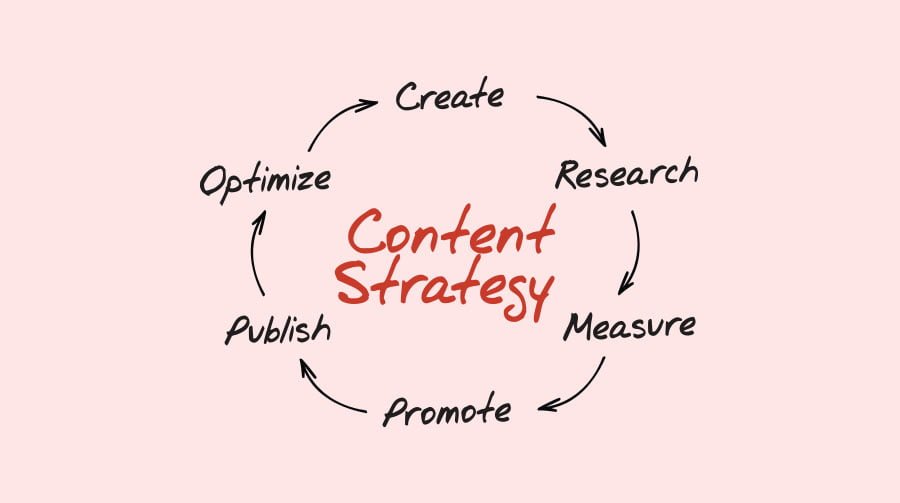
Content repurposing is a content strategy used by many digital marketers. To repurpose content, is to take old, existing content, usually evergreen, take its core message and present it in a different post format or expand the original content with new insights, data, statistics or graphics.
Content repurposing is a powerful way to scale your content but, it is often misunderstood by many people who believe that content repurposing just copying and pasting the same content over and over with a slightly different title.

I don’t think I need to tell you that simply copying and pasting the exact content into a new post will not work. It’s important that you present the argument in a new light or a new post format.
Why Should You Repurpose Old Content?
By using the top tips in this article you can start repurposing content for social media and different mediums in no time at all. By adapting your content to different post formats, it enable you to attract a bigger audience, allow you to grab the attention of people you previously missed out on and get some SEO benefit as a bonus.
I could give you a tonne of reasons why you should repurpose content on your blog, but instead, I chose a few standout points.
Benefits of Content Repurposing
- Appeal to a Wider Audience. When repurposing content by taking a different angle or creating alternative mediums, you increase your potential to appeal to a wider audience
- Get Free Organic Traffic. It’s well known that Google favours fresh content. By repurposing your blog’s content and adding additional articles, you will generate more organic traffic to your posts, increasing traffic to your older posts.
- Gain more SEO Juice. When you repurpose content by rewriting the content, adding new information or even adding new media, you give off positive SEO signals to Google. If you properly optimise your new content with low competition keywords, including relevant internal links, and you follow up with some content marketing, it can really help with your Page Authority and ultimately increase the domain authority of your blog.
- Become an Authority. When your blog covers a topic in-depth, provides all of the tips, tricks and even the special sauce, it helps your blog become an authority in your niche. Repurposing content will allow you to expand on previously thin categories and reinforce the value your blog brings to the internet.
- Maximise your investment. You might sit and say to yourself that your content didn’t cost you anything. But it did! It cost you time. Time is a precious commodity. Your time should be used wisely. You took great time and effort in researching facts and statistics. You took more time planning your content and even more time writing it. By adapting old posts and articles, you can maximise your investment and keep traffic flowing to old pages of your blog.
Repurposing content on your website is a great way to maximise your time investment and create content for social media and other marketing channels you would have otherwise missed.
How Content Repurposing Impacts Website SEO
It’s been a decade since Googles freshness algorithm update in 2011, which was developed to help Google better understand a website’s topic, its ‘freshness’ and determine if it needs to compete against other domains for rankings.
First, by identifying your previously popular evergreen content and building on its core message with updated literature, data or presenting it in new post formats, you can create a stronger internal link structure and keep Google’s freshness algorithm satiated.
Another great SEO benefit to repurposing content is its impact on your search rankings. When the post was first created, you may have optimised your content around keywords that were once popular but have since lost their zing.
When you repurpose content and optimise it for relevant, up to date keywords, you give your content, new ranking power it didn’t have before.
How to find Content for Repurposing
Learning how to find content for repurposing is not challenging. All you need to do is find your evergreen content that is already popular and receiving a decent amount of traffic and engagement from organic sources.
I’m going to show you my method for repurposing content on your blog.
Bonus: You can apply these content repurposing methods to create social media content as well!
1. Check Google Analytics
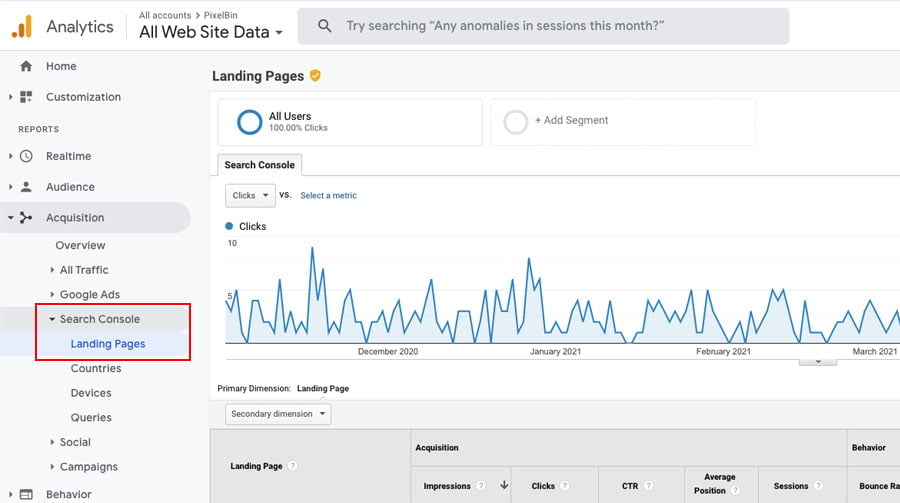
You can find out what your top performing pages currently are by going to your Google Analytics Dashboard and taking a peek at your landing page report which shows you what pages on your blog generate the most traffic.
2. Note content relevant today
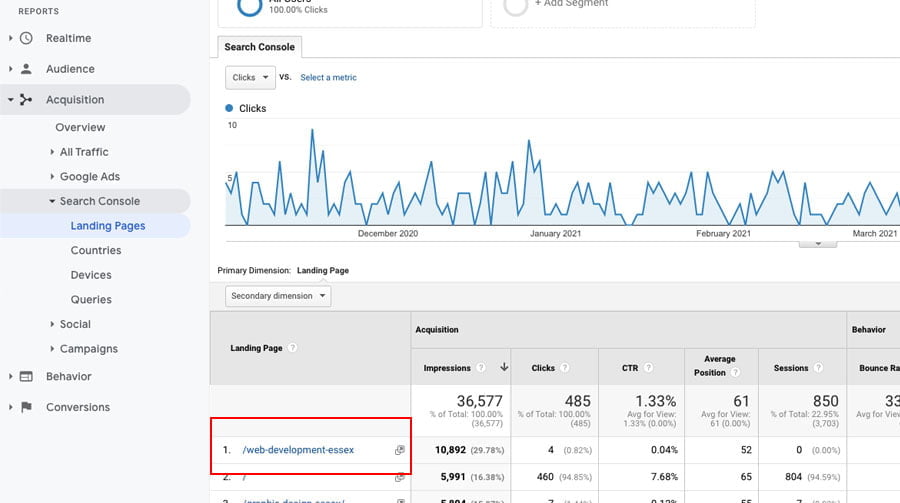
Once you have opened your landing page report in GA and ordered your results by the number of sessions generated, you need to note down long-form content that is still relevant in today’s world.
3. Conduct new keyword research
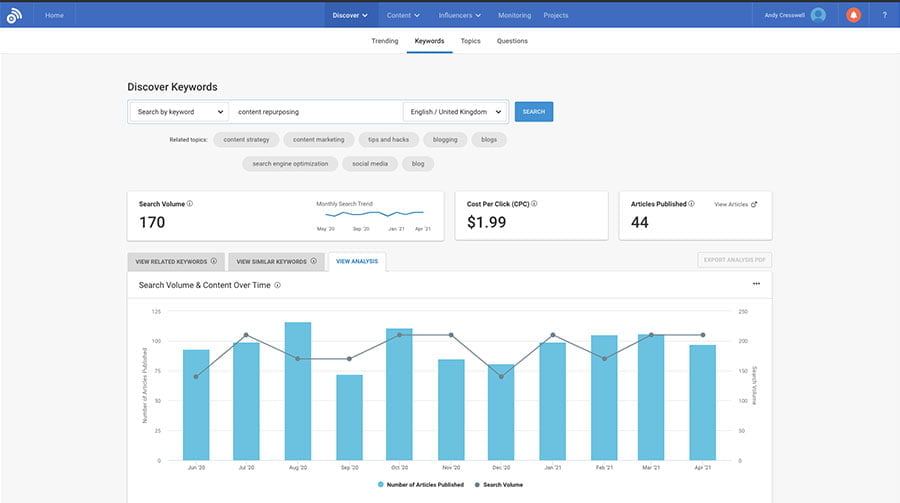
So you now have a list of pages, articles and posts on your website that generate the highest amount of traffic and engagement. However, while still performing really well, those pages will likely be targeting old keywords that can be expanded upon with modern variations.
You can conduct keyword research using services such as ahrefs keyword explorer or Buzzsumo. Using these SEO tools, you can find new low competition keywords to increase your audience reach and improve your blogs search engine optimisation (SEO) potential.
4. Update the original article
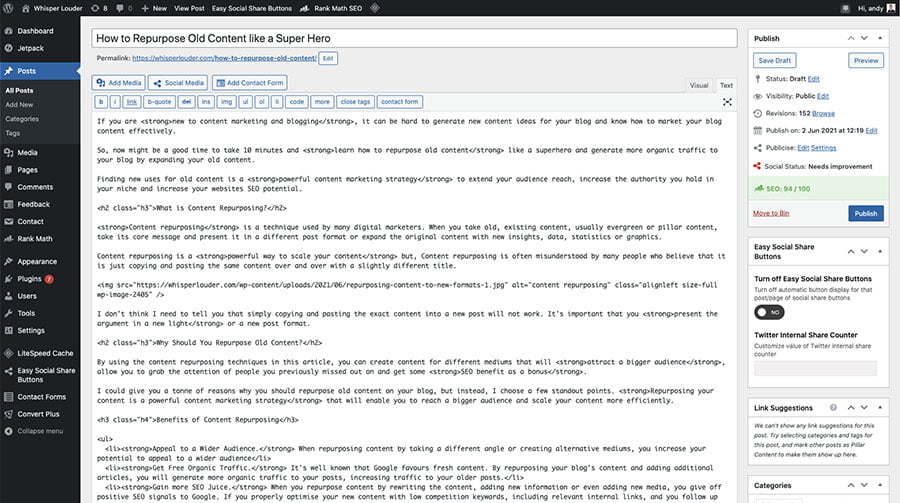
Before repurposing content into new post formats, you should have a little spring clean first.
Go through each article one by one, read through the content and see if anything is outdated and needs removing. Once you have done that, collect some research and statistics that are relevant today and update the original content.
You can choose to skip this step, but I wouldn’t recommend it.
5. Adapt your content to a new post format
Once I have updated my content with new keyword targets, removed outdated information and replaced them, I will then start repurposing content into new post formats.
Post formats are at the core of content repurposing. They allow you to recycle old content into new formats that can be used to reach new audiences. In addition, recycling content with various post formats is a great way to create content for social media and other platforms – not just your blog.
15 Ways to Repurpose Content
Below you will find 15 methods to repurpose content on your website, scale easier, generate more traffic to your post, attract a wider audience to your blog and appeal to a wider audience on other platforms.
1. Create Spin-off articles & posts

Did you know that it’s easy to create more content for your existing blog posts? Converting a listicle into independent articles covering each point in more depth is a great example.
If you take the first four points of this article as an example;
- Create Spin-off articles & posts -> The Benefits of Creating Spin-off Content
- Add an Infographic -> How to create infographics for your blog posts
- Convert Content into a Video -> How to create explainer videos for your blog posts
- Optimise Content for Additional Keywords -> How to add additional keywords to your content
By breaking a listicle down into sections and creating a post on its own, you can expand on the original content and provide more value to your readers by including tutorials, statistics and information. Of course, not all listicle items will be suitable, but you should be fine if you use the 8:1 rule.
The 8:1 content repurposing rule says; For each listicle or piece of sky scrapper content, you should be able to generate eight smaller posts of content.
2. Create an Infographic

Infographics are an excellent visual marketing tool that can be utilised to share information and educate readers in the process. Infographics are a visual way to describe statistics, concepts, products, services or actions in a way that is easy to understand for readers.
Infographics and other colorful visuals can increase sales by up to 80%. (Xerox)
Hiring an Infographic Designer on Fiverr is a great way to leverage the power of infographic marketing for your blog (or business). The great thing about infographics is increasing your SEO power with highly linkable content and keeping search engines happy with updated, fresh content.
3. Convert Content to an Explainer Video
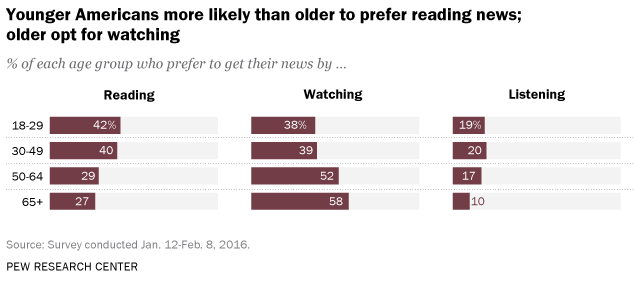
It’s been shown that younger people prefer reading but, the older generation still prefer watching video.
If you are not already leveraging video content for marketing for your blog articles, why not hire someone to convert your blog articles into animated explainer videos? It’s a great way to repurpose your old content and increase the engagement on your website.
The person you hire to convert your blog to video will normally take care of everything, including the script and motion graphics creation meaning, in most cases, you won’t need to lift a finger or possess any skills in Adobe after effects or Adobe Premiere Pro.
4. Optimise Content for Additional Keywords

What better way to increase your SEO authority than by optimising your existing blog content and adding additional low competition keywords will give your content more search engine power.
Search engine optimisation (SEO) is a marketing strategy that is ongoing and should continuously evolve as time and search engine results progress. Optimising your content for additional keywords will power up your old blog posts giving your website a further reach.
Keyword optimisation will require you to add new content to your old blog posts giving them extra SEO power as well as repurposing your content.
5. Add some statistics or facts
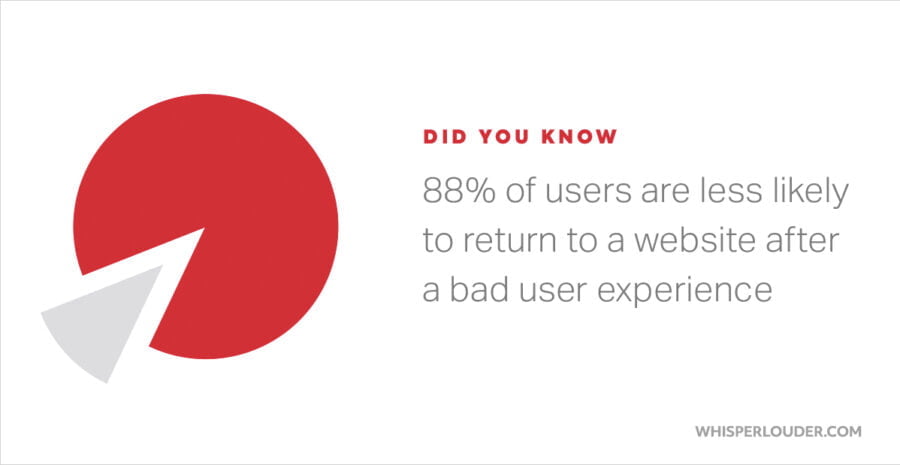
Just like an episode of Dallas has not aged so well in the 21st century, the same is true for some of your content. Old statistics and facts may become obsolete, so it is good to update them with relevant information.
Adding new research, links and even adding entirely new sections is the perfect way to keep your content relevant and up to date.
6. Create a Presentation
Much like infographics, Presentations or slide decks, as they are also known, are another powerful visual marketing tool that can be used to turn existing content into potential backlink opportunities. Like in meetings, slide decks are a great way to quickly deliver a message through statistics, graphics, and visuals.
Presentations can be created using a variety of free services such as Google Slides which also provides templates to avoid much of the boilerplate work.
Once you have created your presentation and posted it on your website, the same content can double up and provide some SEO benefit. In addition, you can distribute your slides on different platforms to get some new backlinks.
7. Create Content for Social Media

Creating content for social media using content repurposing is easy and will increase the authority you hold in your niche. For example, including social media in your marketing campaign is there a perfect way to drive traffic to your blog, help generate fresh backlinks and signalling the content is still relevant in today’s world.
If you are on WordPress, there are some plugins that will automatically syndicate your content to various social media platforms automatically freeing up your time for more important tasks like networking and guesting posting.
8. Email Marketing Campign

Pillar content, or as it’s sometimes known, skyscraper content, is the bread and butter of blogging but, unlike a bottle of fine red wine that ages with time nicely, old content doesn’t.
Did you know that you can repurpose old content with email marketing? It’s a great way to get fresh eyes on your content and generate some free traffic on your blog.
Email marketing normally receives around a 3.43% click through rate. Source.
If you are already using an email capture service such as Mailchimp or Zoho, then you will have access to email building tools that you can use to raise content from the grave. It only takes 15 minutes to set up a daily email campaign and resurrect old content.
9. Content Upgrades
Bloggers commonly use content upgrades to capture more leads by offering bonus content in exchange for their email address. Content upgrades are lead magnets because they target readers interests specifically and generate qualified leads to sell later.
Content upgrade ideas
- Content checklist
- Convert blog to PDF version
- Cheat sheet
- Transcripts
- Case studies
- Reports
- Printable content
- Worksheets
- Templates
- eBook
- Exclusive video interviews
- Support video content
- Free Course
There are loads more ways you can upgrade your content, capture more leads and repurpose your old content to bring a new lease of life to stagnant articles.
10. Write a Guest Post
Guest posting on authority websites is an SEO strategy to generate more natural backlinks to your website and help search robots understand your content. If you have not done any guest blogging before then, you should consider this method to help drive qualified traffic to your blog and increase your website’s authority.
62.96% of readers perceive blogs with multiple authors to be more credible. Source
When you guest post and include a link back to your own website, that is an SEO vote towards your blog. The more links you hold, the easier your content will rank in search engine results in the future.
11. Create a Podcast or an Audio Book

Podcasts are growing rapidly, with over 48 million episodes currently available on the internet. It’s a great way to target a new audience and repurpose your content. Podcasting allows you to build more authority as a brand by becoming a recognisable name on various platforms.
One of my favourite podcasts is The Futur by Chris Do, where he repurposes and expands on his authoritative video content that has provided so much value over the years.
12. Repurpose Webinars
So you hosted a webinar not too long ago, and it was an outstanding success. You attracted many attendees, a tonne of backlinks, and you are still generating fresh engagement and new website visitors today.
You can repurpose that webinar content into smaller bitesize chunks by editing the original video footage and creating a series of YouTube episodes that break down the session and include additional opinions and facts.
YouTube generates over 4 billion views a month and is a great way to immortalise your content and attract a new audience to your website while also offering welcome content upgrades that will increase the engagement of the website.
13. Interview Influencers & Add key Points
Influencer marketing is a trend that is growing in popularity. With the explosion of social media, with it has come a new bread of digital marketer.
You can leverage an influencers network by interviewing them on key topics, industry problems, and even their workflow or methodologies.
36% of brands still tend to pay their influencers with free product samples (or even just discounts on more expensive products) rather than paying cash to their influencers. Source
Interviewing influencers in your niche is a great way to gain a fresh perspective on the topic and likely raise points you have not thought about. After all, two heads are better than one.
Once you have done the interview, you can write an article about the interview, link back to your old content that needs repurposing and includes a transcript.
14. Post on Quora
Quora is a Q&A website where people post a question but, it’s down to the public to answer them. Oh, it’s also one of the most trafficked websites in the world with over 300 million visitors a month.
According to Quora’s B2B Marketing Guide and based on a 2017 study, 54% of Quora users report an annual household income greater than $100,000—meaning they bring significant purchasing power to the website. Source.
It’s easy to use Quora to repurpose old content and also generate some free targeted traffic to your posts. All you need to do is head over Quora.com, sign up for an account and search for questions related to your content that you can easily answer.
Once you have rewritten your original piece of content and answered their question, you might want to also add a backlink to increase your SEO power. Links are nofollow but, they have the potential to generate referral traffic to your blog.
15. Include Twitter Posts
Why not try embedding Twitter posts in your old content to bring a unique perspective and increase the chances of engagement on social media in the meanwhile?
Having a conversation w/ @tomrossmedia about building community on Youtube right now.
Join us: https://t.co/ujoHP2NGSY— Chris Do (@theChrisDo) June 3, 2021
Twitter is full of colourful, interesting and sometimes weird people who share insights, statistics, and even breaking news on their Twitter accounts. Using Twitter’s embed code is a great way to include those informative Tweets in your content and keep your content up to date and relevant.
Content repurposing is a powerful digital marketing tool that can be used to build on existing content and breathe a new lease of life into a dead category on your blog by appealing to a broader audience and bringing some SEO benefits with it.
When you are stuck on writing ideas, then remember these tips. Using existing content that is already receiving traffic and presenting it in a different format or adding additional, date-specific information will open up a world of ideas for new blog content and traffic opportunities.
If you are not already employing these content repurposing methods, then you should upgrade your digital marketing strategy and start repurposing your old content for different mediums and attract a bigger audience to your blog.
